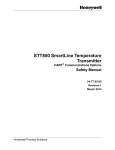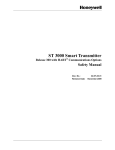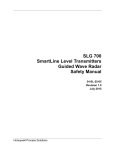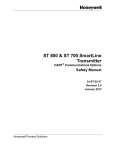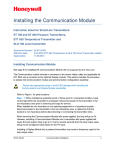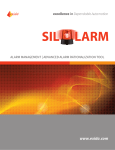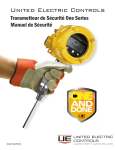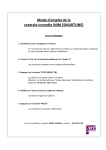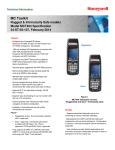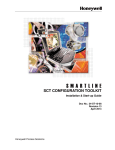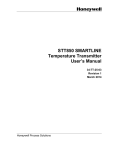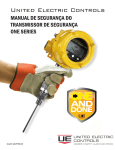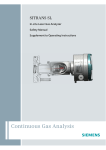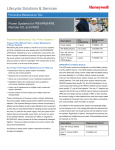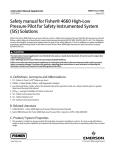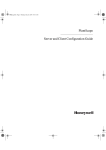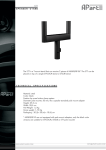Download STT 850 and STT 750 SmartLine Temperature Transmitter HART
Transcript
STT 850 and STT 750 SmartLine Temperature Transmitter HART® Communications Options Safety Manual 34-TT-25-05 Revision 2 August 2015 Honeywell Process Solutions Copyrights, Notices and Trademarks − © Copyright 2015 by Honeywell, Inc. Revision 2, August 2015 − While the information in this document is presented in good faith and believed to be accurate, Honeywell disclaims any implied warranties of merchantability and fitness for a particular purpose and makes no express warranties except as may be stated in the written agreement with and for its customers. In no event is Honeywell liable to anyone for any indirect, special, or consequential damages. The information and specifications in this document are subject to change without notice. Honeywell, TDC 3000, SFC, SmartLine, PlantScape, Experion PKS, and TotalPlant are registered trademarks of Honeywell International Inc. Other brand or product names are trademarks of their respective owners. Honeywell Process Solutions 1250 W Sam Houston Pkwy S Houston, TX 77042 ii STT 850 & STT 750 Safety Manual August 2015 About This Document Release Information STT 850 and STT 750 SmartLine Transmitter HART® Communications Options Safety Manual, # 34-TT-25-05. Revision 1 2 Date of Change Details of Change March 2014 August 2015 1 Release (STT 850 only) STT 750 Temperature Transmitter added. st References The following list identifies publications that may contain information relevant to the information in this document. STT 850 • STT 850 SmartLine Temperature Transmitter Specifications, 34-TT-03-14 • STT 850 SmartLine Temperature Transmitter Quick Start Installation Guide, # 34-TT-25-04 • ST T 850 SmartLine Temperature Transmitter User Manual, Document # 34-TT-25-03 • STT 850 SmartLine Temperature Transmitter HART/DE Option User’s Manual, # 34-TT-25-06 STT 750 • STT 750 SmartLine Temperature Transmitter Specification, 34-TT-03-16 • STT 750 SmartLine Temperature Transmitter Quick Start Installation Guide, # 34-TT-25-14 • ST T 750 SmartLine Temperature Transmitter User Manual, Document # 34-TT-25-13 • STT 750 SmartLine Temperature Transmitter HART Option User’s Manual, # 34-TT-25-16 Patent Notice The Honeywell STT 850 SmartLine Temperature Transmitter family is covered by one or more of the following U. S. Patents: 5,485,753; 5,811,690; 6,041,659; 6,055,633; 7,786,878; 8,073,098; and other patents pending. August 2015 STT 850 & STT 750 Safety Manual iii Support and Contact Information For Europe, Asia Pacific, North and South America contact details, refer to the back page of this manual or the appropriate Honeywell Solution Support web site: Honeywell Corporate www.honeywellprocess.com Honeywell Process Solutions www.honeywellprocess.com/temperature-transmitters/ Training Classes http://www.honeywellprocess.com/en-US/training Telephone and Email Contacts Area iv Organization Phone Number United States and Canada Honeywell Inc. 1-800-343-0228 Customer Service 1-800-423-9883 Global Technical Support Global Email Support Honeywell Process Solutions [email protected] STT 850 & STT 750 Safety Manual August 2015 Terms and Abbreviations 1oo1 Basic Safety DU FMEDA Functional Safety GTS ® HART HFT Low demand mode PFDAVG Safety Safety Assessment SFF SIF SIL SIS August 2015 One out of one The equipment must be designed and manufactured such that it protects against risk of damage to persons by electrical shock and other hazards and against resulting fire and explosion. The protection must be effective under all conditions of the nominal operation and under single fault condition Dangerous Undetected failures Failure Modes, Effects and Diagnostic Analysis The ability of a system to carry out the actions necessary to achieve or to maintain a defined safe state for the equipment / machinery / plant / apparatus under control of the system Global Technical Support Center Highway Addressable Remote Transducer Hardware Fault Tolerance Mode, where the frequency of demands for operation made on a safetyrelated system is no greater than one per year and no greater than twice the proof test frequency. Average Probability of Failure on Demand Freedom from unacceptable risk of harm The investigation to arrive at a judgment - based on evidence - of the safety achieved by safety-related systems. Further definitions of terms used for safety techniques and measures and the description of safety related systems are given in IEC 61508-4. Safe Failure Fraction, the fraction of the overall failure rate of a device that results in either a safe fault or a diagnosed unsafe fault. Safety Instrumented Function, a set of equipment intended to reduce the risk due to a specific hazard (a safety loop). Safety Integrity Level, discrete level (one out of a possible four) for specifying the safety integrity requirements of the safety functions to be allocated to the E/E/PE safety-related systems where Safety Integrity Level 4 has the highest level of safety integrity and Safety Integrity Level 1 has the lowest. Safety Instrumented System – Implementation of one or more Safety Instrumented Functions. A SIS is composed of any combination of sensor(s), logic solver(s), and final element(s). STT 850 & STT 750 Safety Manual v Contents Terms and Abbreviations ................................................................................................................. v 1 — Requirements ..................................................................................................... 1 Requirements for use of the manual ................................................................................................... 1 2 — Safety Function ................................................................................................... 2 Primary Safety Functions .................................................................................................................... 2 Secondary Safety Functions ............................................................................................................... 2 Systematic Integrity: SIL 3 Capable .................................................................................................... 2 3 — Designing with the HONEYWELL STT 850 & STT 750 ...................................... 3 Diagnostic Response Time ................................................................................................................. 3 Logic Solver Inputs .............................................................................................................................. 3 Reliability data and lifetime limit .......................................................................................................... 3 Environmental limits ............................................................................................................................ 4 Application limits .................................................................................................................................. 4 4 — Installation with the HONEYWELL STT 850 & STT 750 ..................................... 5 Parameter settings .............................................................................................................................. 5 5 — Operation and Maintenance with the HONEYWELL STT 850 & STT 750 ......... 6 Proof test ............................................................................................................................................. 6 Calibration procedure .......................................................................................................................... 7 Remote Parameter Configuration Verification ..................................................................................... 8 Repair and replacement ...................................................................................................................... 9 Firmware update .................................................................................................................................. 9 vi STT 850 & STT 750 Safety Manual August 2015 This page has been intentionally left blank August 2015 STT 850 & STT 750 Safety Manual vii 1 — Requirements Requirements for use of the manual This section is intended for user’s who have our STT 850 & STT 750 SmartLine Temperature Transmitter with the HART® Communication option with SIL. Any other option is not specifically covered by this manual. IEC 61508 Ed. 2.0 compliant hardware/software revisions for the STT 850 & STT 750 SmartLine Temperature Transmitter can be found in the Exida and TÜV Certification Reports. In addition, the most recent release information can be found in the following document: https://www.honeywellprocess.com/library/support/Public/Downloads/SmartLineHARTTemperat ureFirmwareRevisions.zip This document can be downloaded using the following link: SmartLineHARTTemperatureFirmwareRevisions.zip August 2015 STT 850 & STT 750 Safety Manual 1 2 — Safety Function Primary Safety Functions The HONEYWELL STT 850 & STT 750 measures the temperature (or mV, Volts or ohms) of a process and reports the measurement within a safety accuracy of 2%. Secondary Safety Functions The HONEYWELL STT 850 & STT 750 performs automatic diagnostics to detect internal failures and reports these failures via out of band signals on the 4 – 20 mA output. The transmitter needs a power cycle in order to recover from this condition. Systematic Integrity: SIL 3 Capable SIL 3 Capability: The product has met manufacturer design process requirements of Safety Integrity Level (SIL) 3. These are intended to achieve sufficient integrity against systematic errors of design by the manufacturer. A Safety Instrumented Function (SIF) designed with this product must not be used at a SIL level higher than the statement without “prior use” justification by end user or diverse technology redundancy in the design. This is a Type B device. 2 STT 850 & STT 750 Safety Manual August 2015 3 — Designing with the HONEYWELL STT 850 & STT 750 Diagnostic Response Time The HONEYWELL STT 850 & STT 750 will report an internal failure within 12 minutes of fault occurrence (worst case). The transmitter will be put to burnout output if 1. PV is not updated in 5 seconds 2. 4-20mA Output Current is not as expected in 2.5 minutes 3. Electronics fault is found in 12 minutes (worst case). The transmitter needs to be power cycled in order to recover from the burnout condition. Logic Solver Inputs The logic solver must be configured so that the engineering range in the transmitter matches the expected range of the logic solver. To take advantage of the internal diagnostics in the STT 850 & STT 750, the logic solver must be configured to annunciate an out of band current reading (greater than 20.8 mA. or less than 3.8 mA.) in standard configuration or (greater than 20.5 mA. or less than 3.8 mA.) with Namur configuration as a diagnostic fault. The logic solver configuration must consider the slew time of the current signal and ensure that filtering is used to prevent a false diagnostic failure annunciation. Reliability data and lifetime limit A detailed Failure Mode, Effects, and Diagnostics Analysis (FMEDA) report is available from HONEYWELL. This report details all failure rates and failure modes, common cause factors for applications with redundant devices and the expected lifetime of the HONEYWELL STT 850 & STT 750 AND STT 750. The HONEYWELL STT 850 & STT 750 is intended for low demand mode applications up to SIL 2 for use in a simplex (1oo1) configuration, depending on the PFDAVG calculation of the entire Safety Instrumented Function. STT 850 & STT 750 is classified as type B device according to IEC61508, having a hardware fault tolerance of 0. The development process of the HONEYWELL STT 850 & STT 750 is certified up to SIL3, allowing redundant use of the transmitter up to this Safety Integrity Level, depending the PFDAVG calculation of the entire Safety Instrumented Function. When using the HONEYWELL STT 850 & STT 750 in a redundant configuration, a common cause factor should be included in reliability calculations. For reliability calculation details, useful lifetime and SFF, see the FMEDA report. The reliability data listed the FMEDA report is only valid for the useful life time of the HONEYWELL STT 850 & STT 750. The failure rates of the HONEYWELL STT 850 & STT 750 may increase sometime after this period. Reliability calculations based on the data listed in the FMEDA report for mission times beyond the lifetime may yield results that are too optimistic, i.e. the calculated Safety Integrity Level will not be achieved. August 2015 STT 850 & STT 750 Safety Manual 3 Environmental limits The environmental limits of the HONEYWELL STT 850 & STT 750 are specified in the customer spec sheets as given in the STT 850 & STT 750 Specification 34-TT-03-14. Application limits The application limits of the HONEYWELL STT 850 & STT 750 are specified in the User Manual. If the transmitter is used outside of the application limits the reliability data provided becomes invalid. 4 STT 850 & STT 750 Safety Manual August 2015 4 — Installation with the HONEYWELL STT 850 & STT 750 The person with knowledge of safety operations will be required to do the installation and operation. No special installation is required in addition to the standard installation practices outlined in the STT 850 & STT 750 Smart Transmitter User Manual. However please note that when the device is in safety operation the optional write protect must be set in hardware and software both so that the device is write protected and HART® devices must be disconnected. This can be done using the write protect jumper. See STT 850 & STT 750 Smart Transmitter User Manuals for details concerning the write protect jumper (STT850 – 34-TT-25-03, STT 750 – 34-TT-25-13). Also note that when the device is in safety operation the Latching and Break Detect parameters must be enabled. The software write protect is also available in the device with a password to disable the software write protect. The default password is “0000”. It can be enabled / disabled through HART host. IEC 61508 Ed. 2.0 compliant hardware/software revisions for the STT 850 & STT 750 can be found in the Exida and TÜV Certification Reports. In addition, the most recent release information can be found in the following document: https://www.honeywellprocess.com/library/support/Public/Downloads/SmartLineHARTTemperat ureFirmwareRevisions.zip Parameter settings The following parameters need to be set in order to maintain the designed safety integrity: mA Fault action (Upscale/Downscale) The transmitter is shipped with a default failsafe direction of upscale (21.5 mA.). This is acceptable for all high trip applications. For low trip applications, the fail-safe direction is downscale (3.5 mA.). A jumper on the transmitter may be changed to accomplish this action, see the User Manual. Engineering Range All engineering range parameters must be entered to match the trip points in the safety logic solver. These parameters must be verified during the installation and commissioning to ensure that the correct parameters are set in the transmitter. Engineering range parameters can be verified by reading these parameters from the local display or by checking actual calibration of the transmitter. August 2015 STT 850 & STT 750 Safety Manual 5 5 — Operation and Maintenance with the HONEYWELL STT 850 & STT 750 Proof test The objective of proof testing is to detect failures within the HONEYWELL STT 850 & STT 750 that are not detected by the automatic diagnostics of the transmitter. Of main concern are undetected failures that prevent the safety instrumented function from performing its intended function. The frequency of proof testing, or the proof test interval, is to be determined in reliability calculations for the safety instrumented functions for which the HONEYWELL STT 850 & STT 750 is applied. The Exida exSILentia® tool is recommended for these calculations. The proof tests must be performed more frequently than, or as frequently as specified in the calculation in order to maintain the required safety integrity of the safety instrumented function. The following proof test is recommended. It consists of a simple HART® driven min to max output test. The results of the proof test need to be documented and this documentation should be part of a plant safety management system. Any failures that are detected and that compromise functional safety should be reported to the Global Technical Support Center (GTS). See STT 850 & STT 750 Smart Transmitter User Manual for more details (STT850 – 34-TT-25-03, STT 750 – 34-TT-25-13). . Step Action 1 Bypass the safety PLC or take other appropriate action to avoid a false trip, following Management of Change procedures. 2 Send a HART command to the transmitter to go to the high alarm current output and verify that the analog current reaches that value. ® This procedure tests for compliance voltage problems such as a low loop power supply voltage or increased wiring resistance. This also tests for other possible failures. 3 Send a HART® command to the transmitter to go to the low alarm current output and verify that the analog current reaches that value. This test checks for possible quiescent current related failures. 4 Use the HART® communicator to view detailed critical and non-critical device status to ensure no alarms or warnings are present in the transmitter. 5 Verify all safety critical configuration parameters. 6 The WP jumper state should be checked to see if it is in WP mode first, and then changed to Enable to ensure a change is detected by device while configuring, and then moved back to WP after the configuration is complete. Then it should be verified again. 7 Calibrate the device as per calibration procedure given below. 8 Restore the loop to full operation. 9 Power cycle or cold reset to clear soft errors in memory (RAM). 10 Remove the bypass from the safety PLC or otherwise restore normal operation. This test will detect approximately 30% of possible DU failures in the transmitter (Proof Test Coverage). An alternative proof test consisting of proof test 1 with actual two point temperature calibration plus verification of the temperature measurement will detect approximately 48% of possible DU failures. 6 STT 850 & STT 750 Safety Manual August 2015 The person(s) performing the proof test of the HONEYWELL STT 850 & STT 750 should be trained in SIS operations, including transmitter maintenance and company Management of Change procedures. Tools required are: handheld communicator. Calibration procedure The transmitter should be taken out of service. The source for the input Temperature must be very precise, and certified for correct operation. Step Action 1 Connect the HART host and establish the communications. 2 Go to Online > Device Setup > Calibration > Calibration Methods menu. 3 Go to “D/A Trim” 4 Message “Warn loop should be removed from automatic control” will appear. Press “Ok”. 5 Message “Connect reference meter” will appear. Connect the reference meter and press “Ok”. 6 Message “Setting fld device output to 4mA” will appear. Press “Ok”. Message “Enter meter value (4,000mA)” will appear with a textbox to enter actual value observed on meter. Enter the actual value and press “Enter”. 7 Message “Fld dev output 4,000mA equal to reference meter?” will appear with Yes/No selection. Select “Yes” and “Enter”. 8 Message “Setting field device output to 20mA” will appear. Press “Ok”. 9 Message “Fld dev output 20,000mA equal to reference meter?” will appear with Yes/No selection. Select “Yes” and “Enter”. 10 Message “Returning fld dev to original output” will appear. Press “Ok”. 11 Now Double click “URV Correct” method 12 Message “WARN-Loop should be removed from automatic control” will appear. Press “Ok”. 13 . Message “Please enter calibration date” will appear. Enter the current date and press “Ok”. 14 Message “Please enter current calibration time in 24 hr clock format (hour field)” will appear. Enter the current time hour and press “Ok”. 15 Message “please enter current calibration time (min field)” will appear. Enter the current time minutes and press “Ok”. 16 Message “Apply URV Temperature” will appear. 17 Adjust the PV input to the required URV value. Press “Ok”. 18 Message “Press ok when Temperature is stable” will appear. Press “Ok” 19 The correct URV operation will happen . 20 Message “Loop may be returned to automatic control” will appear. Press “Ok”. 21 Follow the same procedure for “Correct LRV” (replace URV in above procedure by LRV) and “Correct LRV” operation will get executed. August 2015 STT 850 & STT 750 Safety Manual 7 Remote Parameter Configuration Verification When configuring the HONEYWELL STT 850 & STT 750 through a remote host, it is recommended that parameters that affect the 4-20ma analog output be verified using an alternate utility, before using the transmitter in a SIS. This helps to ensure that the parameters that are entered remotely by the host are not inadvertently changed from the user intended values. The procedure can consist of listing the parameters and their values entered in the host application. Then, using an alternative application, the same parameters are read back and noted in the same form. The form is then signed, dated, and filed for future reference. See Table 1 Example Verification Form for an example of this form. Note that using the same host application to verify the remotely entered values will not provide as much assurance as using an alternate application. Table 1 - Example Verification Form Parameter Host Value Verified Value Verified By: Date: 8 STT 850 & STT 750 Safety Manual August 2015 Repair and replacement Any failures that are detected and that compromise functional safety should be reported to the Global Technical Support Center (GTS). When replacing the HONEYWELL STT 850 & STT 750 the procedures in the installation manual should be followed. Firmware update The user will not be required to perform any firmware updates. If the user has selected the firmware upgrade option, it can be done by Honeywell service representative. August 2015 STT 850 & STT 750 Safety Manual 9 This page has been intentionally left blank 10 STT 850 & STT 750 Safety Manual August 2015 Sales and Service For application assistance, current specifications, pricing, or name of the nearest Authorized Distributor, contact one of the offices below. ASIA PACIFIC EMEA AMERICAS Honeywell Process Solutions, (TAC) [email protected] Honeywell Process Solutions, Phone: + 80012026455 or +44 (0)1344 656000 Honeywell Process Solutions, Phone: (TAC) 1-800-423-9883 or 215/641-3610 (Sales) 1-800-343-0228 Australia Honeywell Limited Phone: +(61) 7-3846 1255 FAX: +(61) 7-3840 6481 Toll Free 1300-36-39-36 Toll Free Fax: 1300-36-04-70 Email: (Sales) [email protected] or (TAC) [email protected] China – PRC - Shanghai Honeywell China Inc. Phone: (86-21) 5257-4568 Fax: (86-21) 6237-2826 Email: (Sales) [email protected] or (TAC) [email protected] Singapore Honeywell Pte Ltd. Phone: +(65) 6580 3278 Fax: +(65) 6445-3033 South Korea Honeywell Korea Co Ltd Phone: +(822) 799 6114 Fax: +(822) 792 9015 For more information To learn more about SmartLine Transmitters, visit www.honeywellprocess.com Or contact your Honeywell Account Manager Process Solutions Honeywell 1250 W Sam Houston Pkwy S Houston, TX 77042 Honeywell Control Systems Ltd Honeywell House, Skimped Hill Lane Bracknell, England, RG12 1EB Shanghai City Centre, 100 Jungi Road Shanghai, China 20061 www.honeywellprocess.com 34-ST-25-05 Rev.2 August 2015 2015 Honeywell International Inc.




















